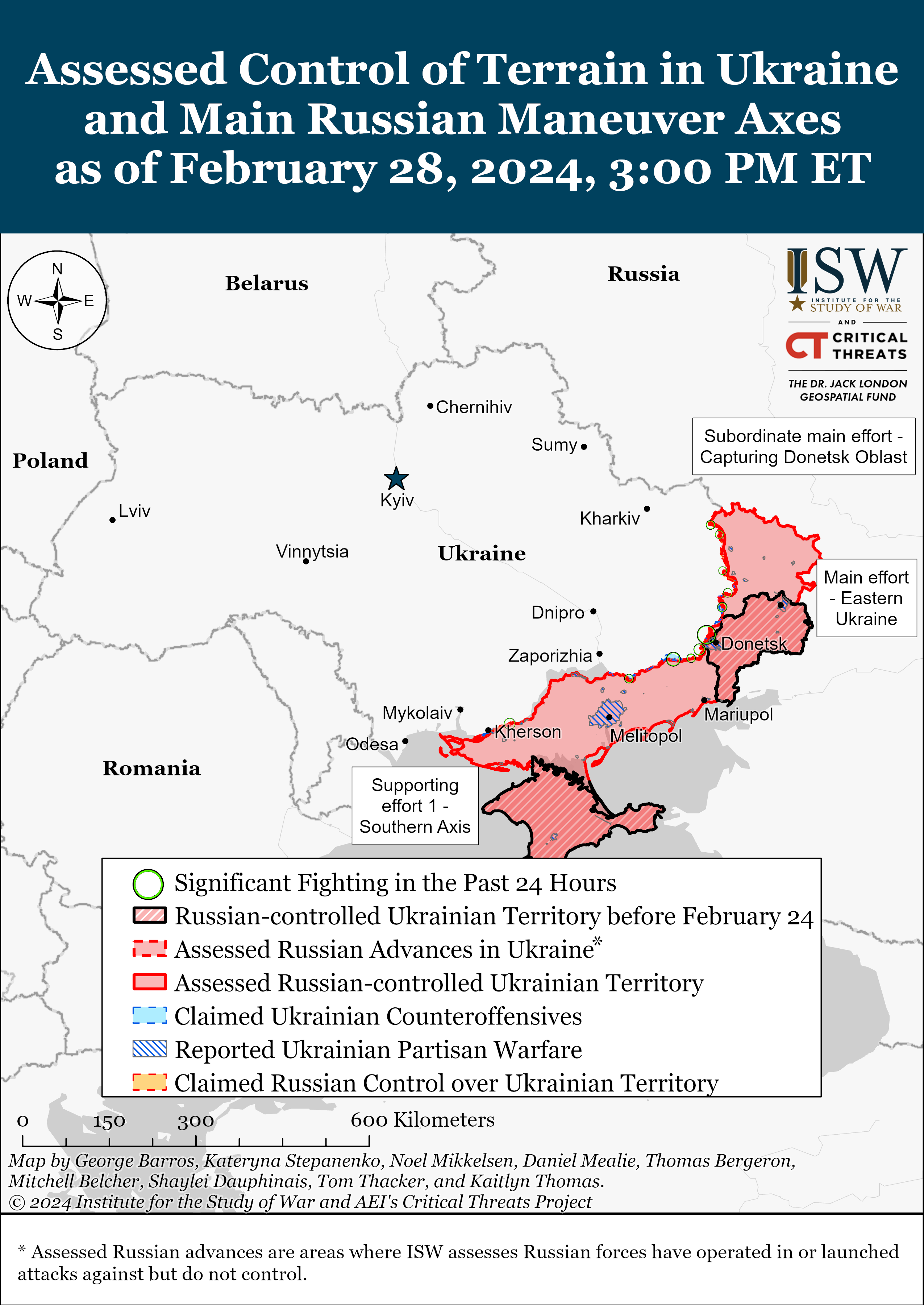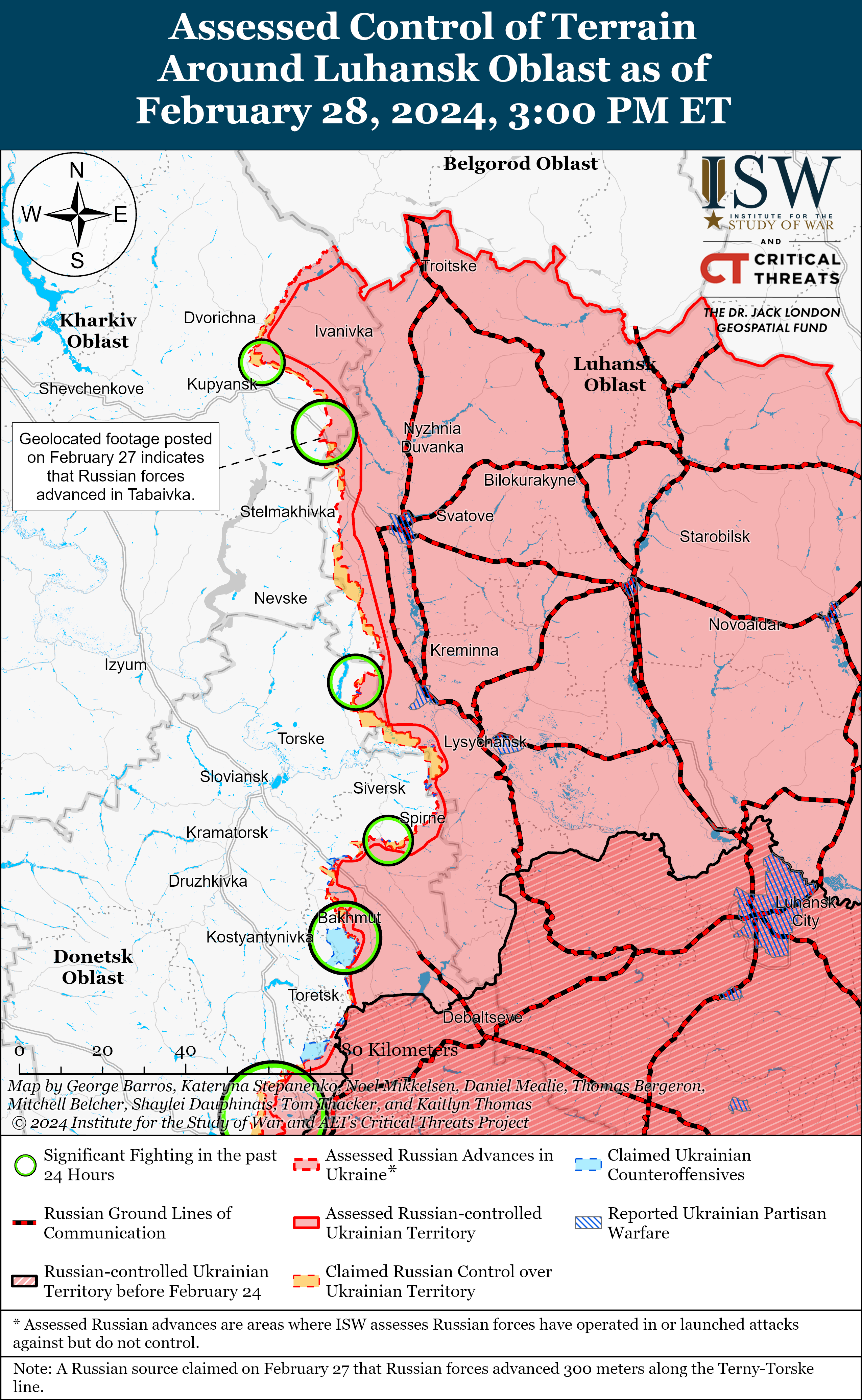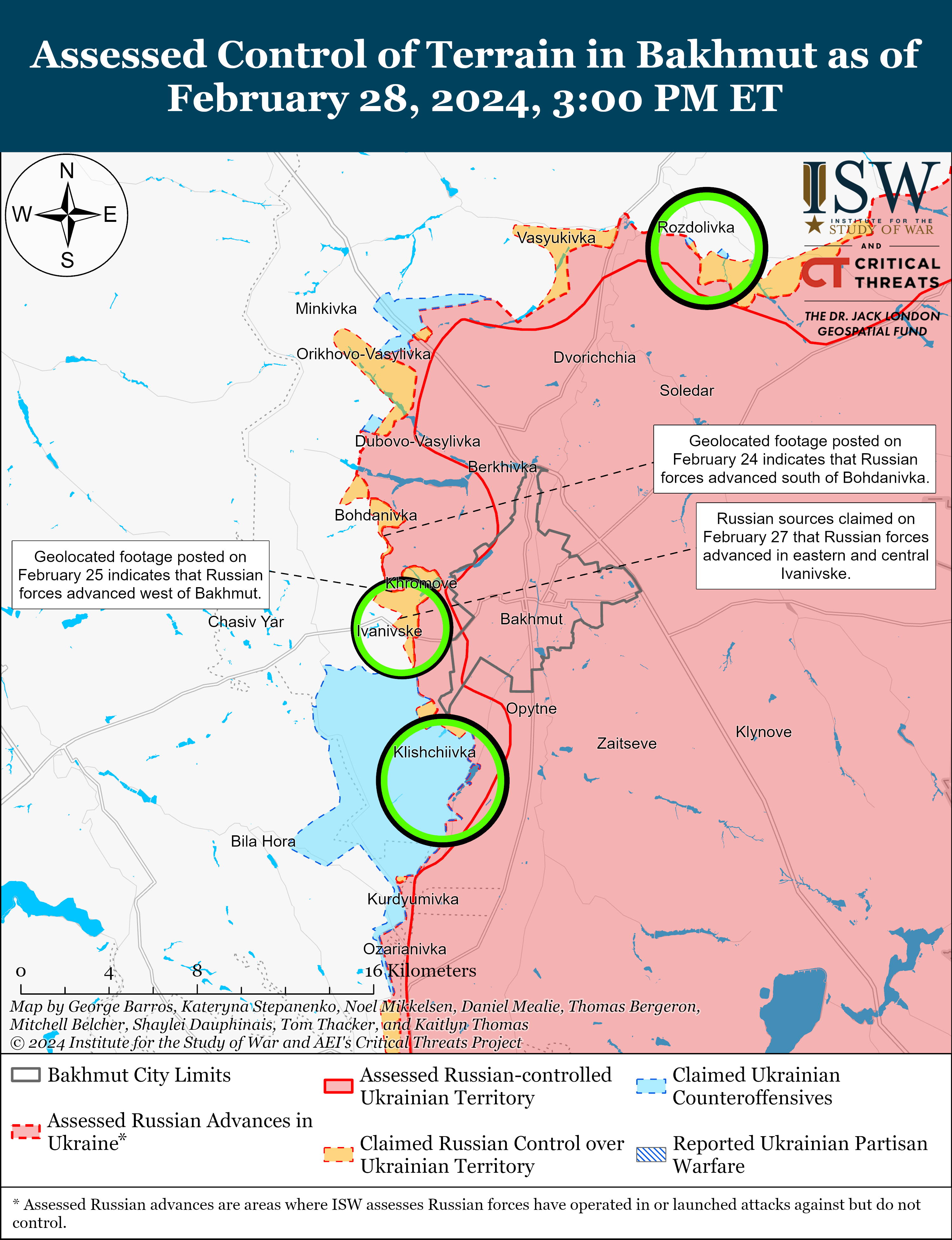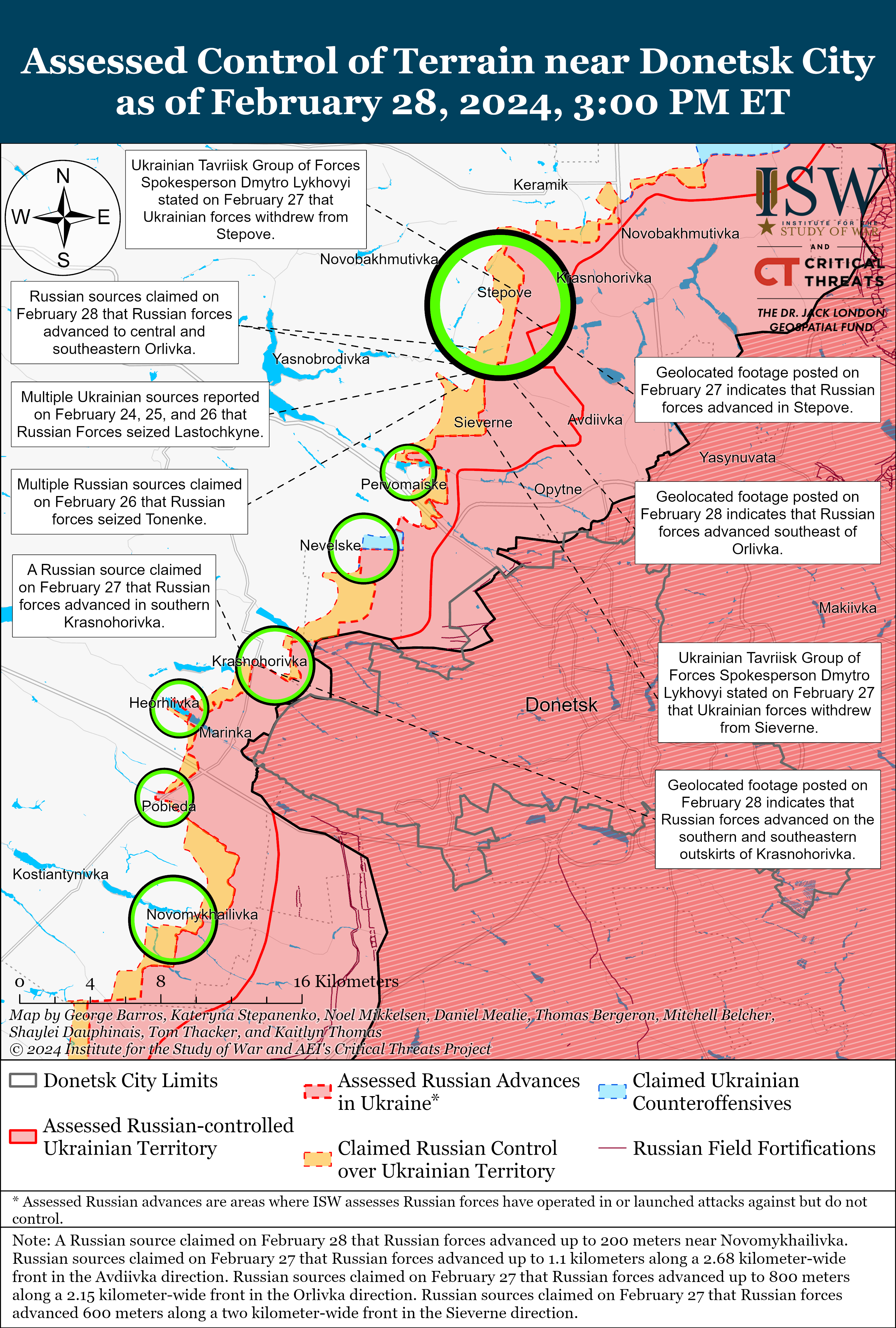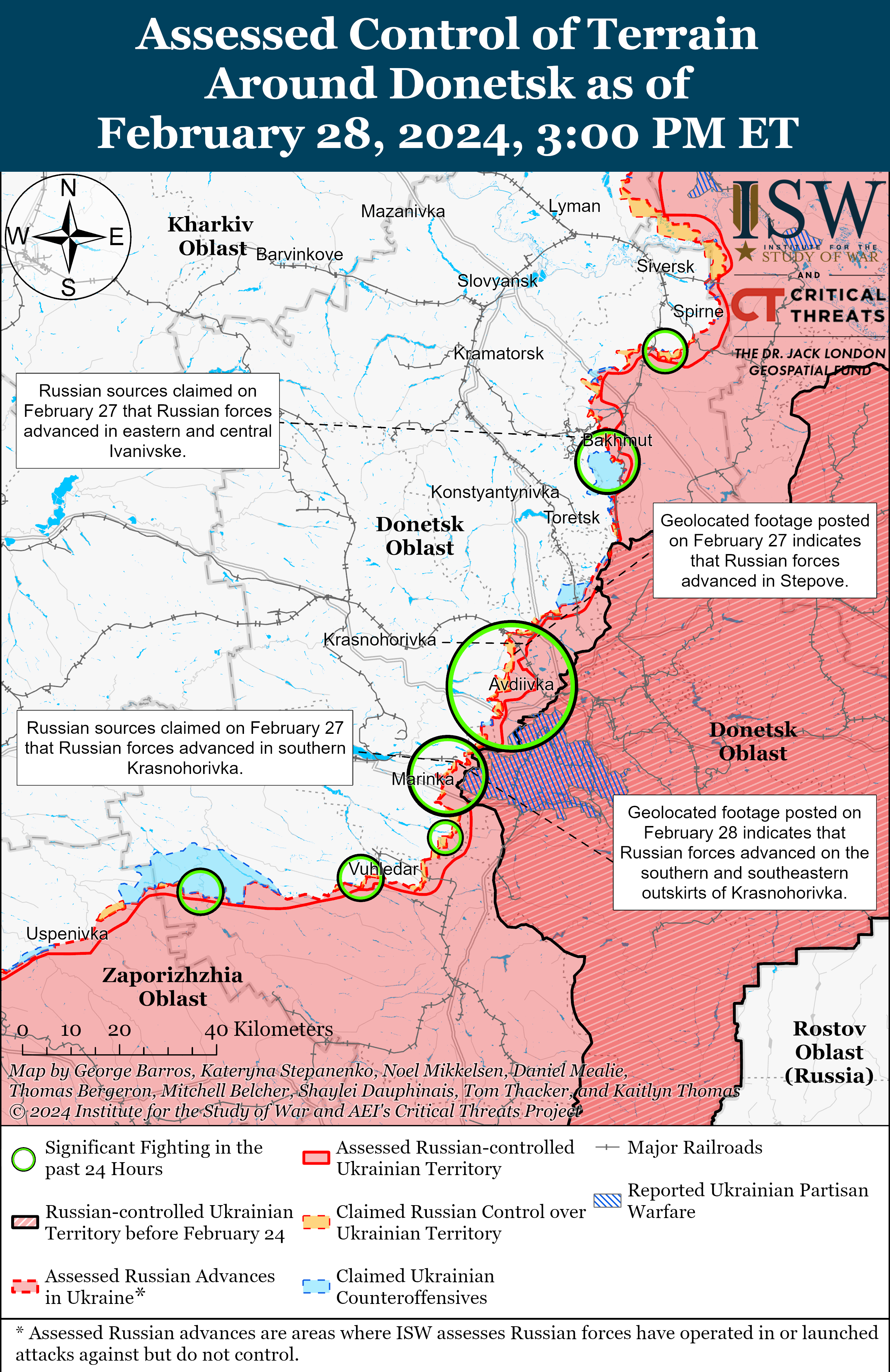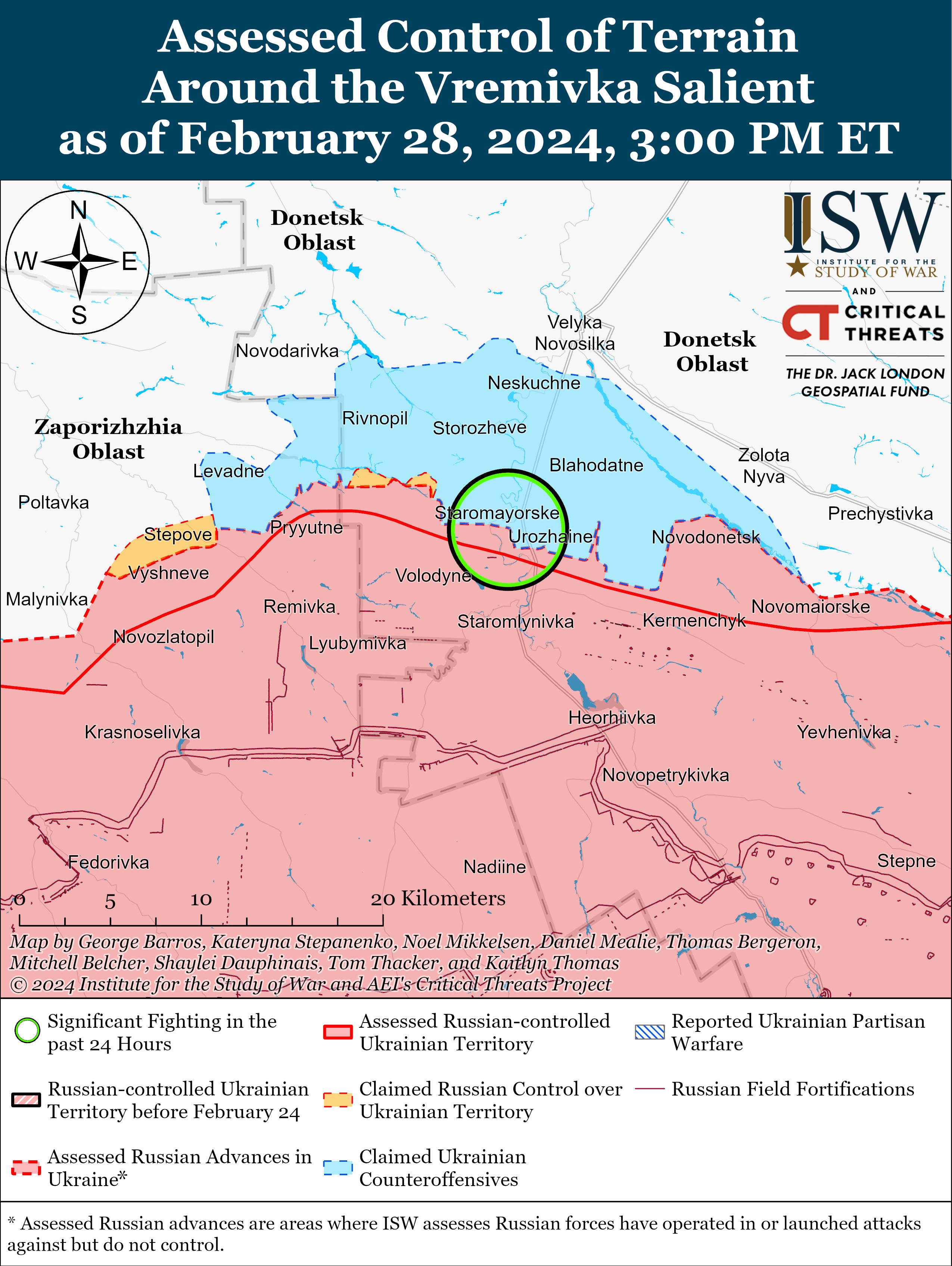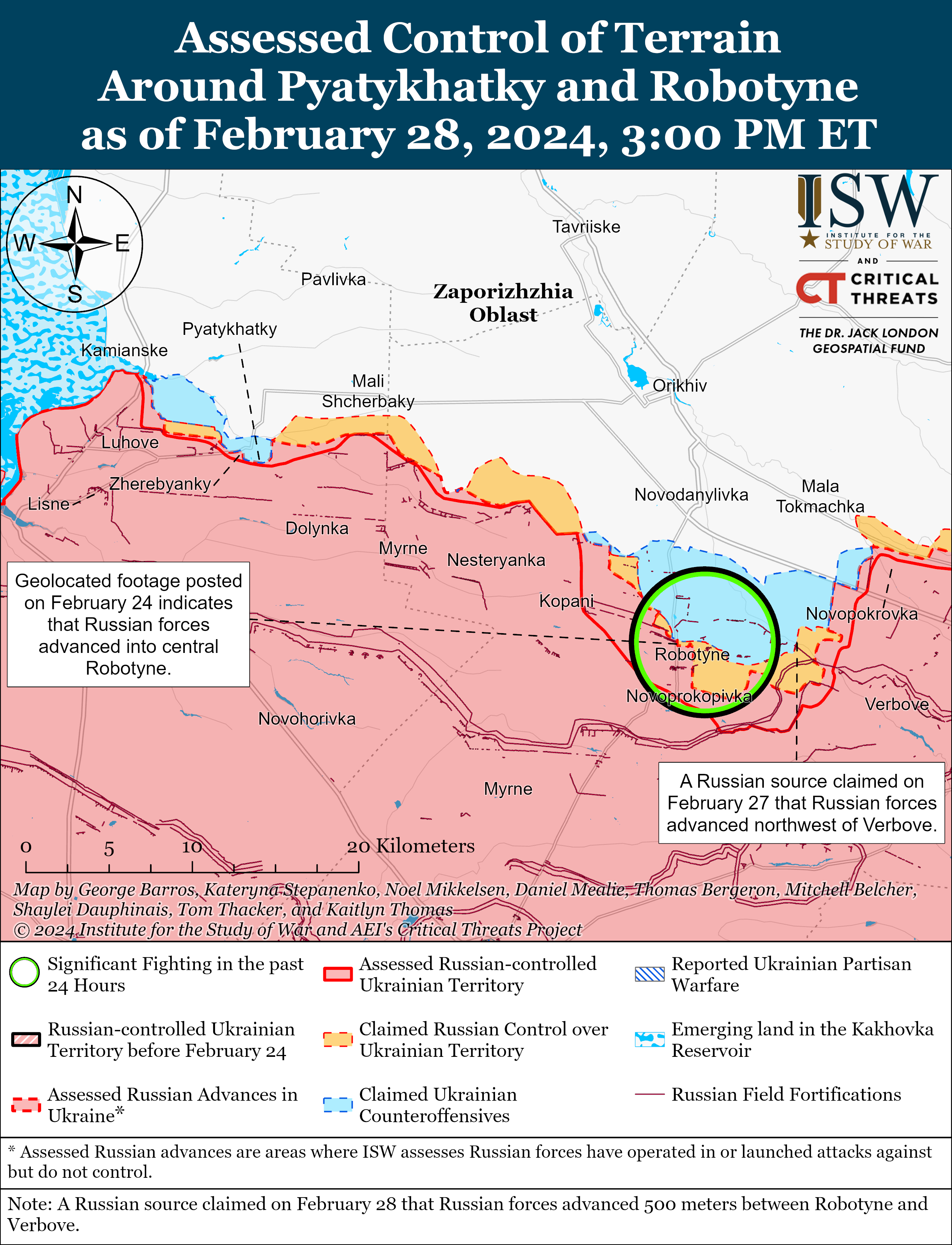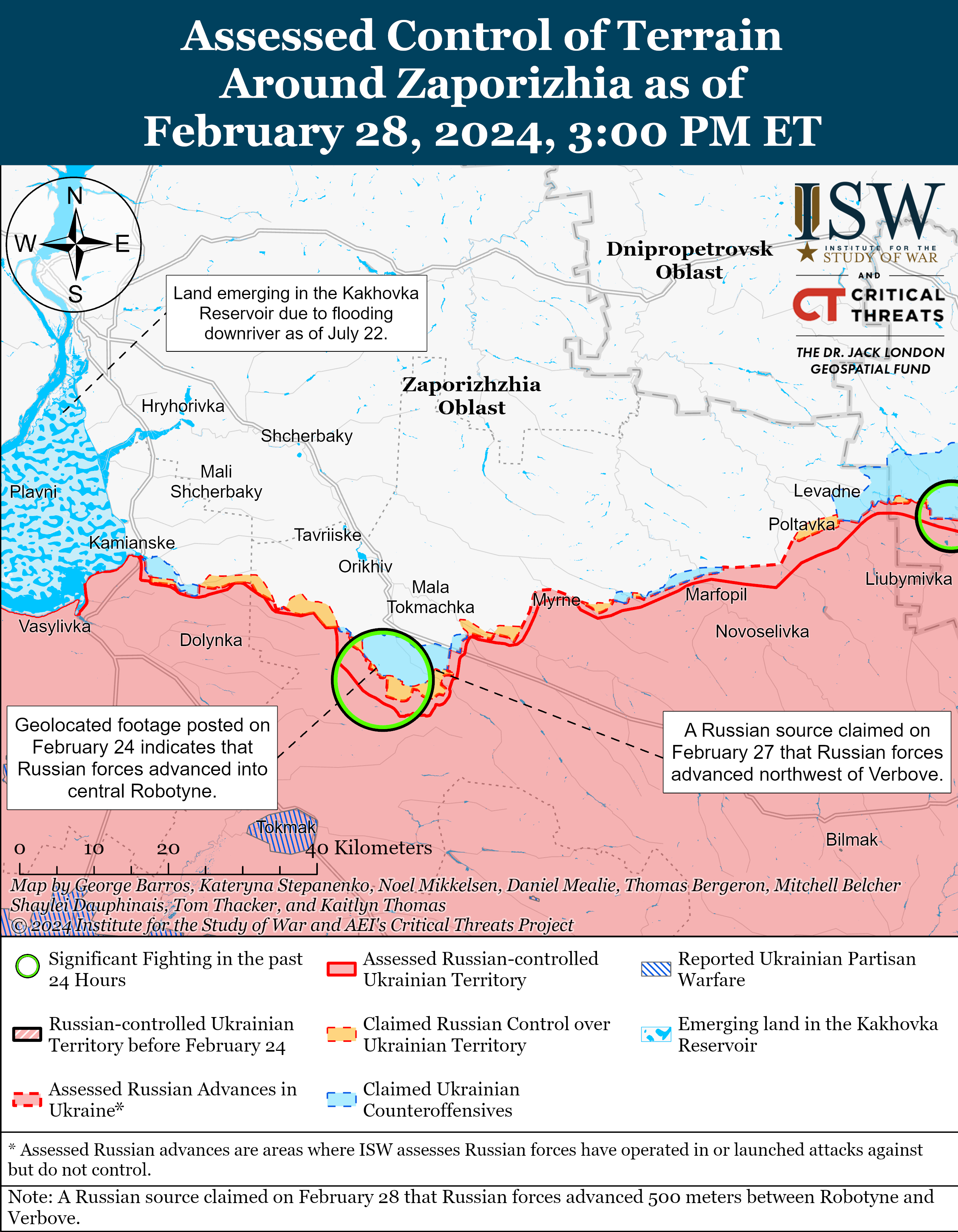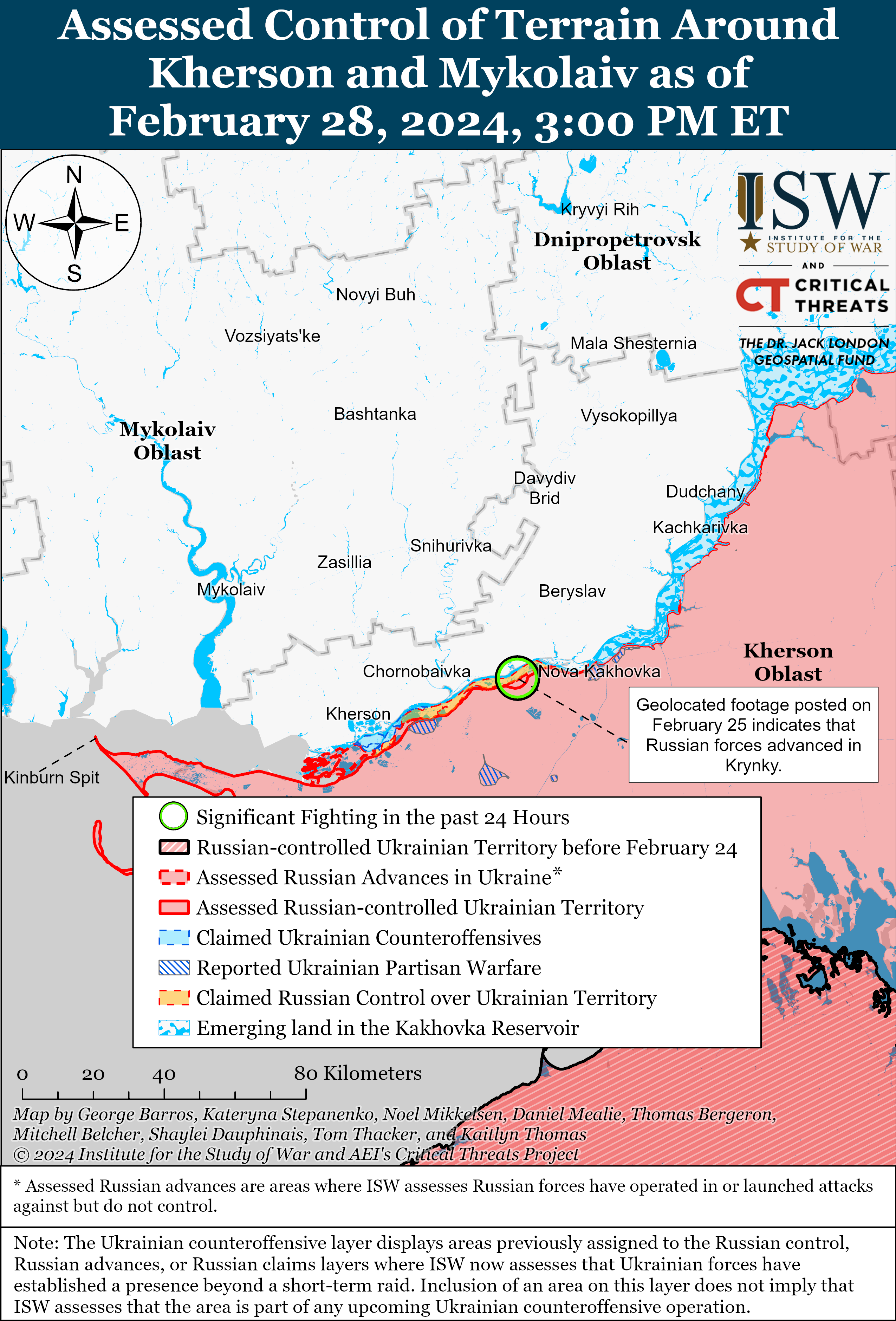 |
 |
Russian Offensive Campaign Assessment, February 28, 2024

Russian Offensive Campaign Assessment, February 28, 2024
Angelica Evans, Riley Bailey, Grace Mappes, Karolina Hird, and Frederick W. Kagan
February 28, 2024, 7:15pm ET
Click here to see ISW’s interactive map of the Russian invasion of Ukraine. This map is updated daily alongside the static maps present in this report.
Click here to see ISW’s 3D control of terrain topographic map of Ukraine. Use of a computer (not a mobile device) is strongly recommended for using this data-heavy tool.
Click here to access ISW’s archive of interactive time-lapse maps of the Russian invasion of Ukraine. These maps complement the static control-of-terrain map that ISW produces daily by showing a dynamic frontline. ISW will update this time-lapse map archive monthly.
Note: The data cut-off for this product was 1:30pm ET on February 28. ISW will cover subsequent reports in the February 29 Russian Offensive Campaign Assessment.
Pro-Russian Moldovan breakaway region Transnistria held the Seventh Congress of Transnistrian Deputies on February 28 and adopted a series of decisions that likely aim to provide the Kremlin with justifications for a wide range of possible escalatory actions against Moldova — actions the Kremlin can pursue both immediately and over the long-term.[1] The Congress of Transnistrian Deputies adopted seven decisions, including a request to the Russian State Duma and Federation Council for Russian “defense” of Transnistria in response to alleged increasing pressures from Moldova. Transnistrian officials specifically used “zashchita” (защита), a word that means both “defense” and “protection” in their request, likely to set conditions for the Kremlin to interpret “defense” in a military sense if it so chooses. Transnistrian officials invoked the obligations of the Russian “peacekeeping mission” in Transnistria and the roughly 220,000 Russian citizens they claim are residing in Transnistria in their request for Russian “defense.” Transnistrian officials likely aim for these appeals to serve as the basis for any potential Russian intervention in Transnistria and Moldova in the near or long term as they cohere with Russian justifications for previous interventions, most notably its invasions of Ukraine.[2] The Kremlin has increasingly promoted rhetoric about Russia’s ”compatriots abroad,” which include ethnic Russians and Russian speakers, to further justify its war in Ukraine and to likely set informational conditions for provocations in countries where Russian ”compatriots” live.[3] The Kremlin has also used the idea of protecting its “compatriots abroad” to justify the fact that Russian troops have occupied Transnistria since 1992, and Transnistrian officials likely made appeals concerning Transnistrian residents with Russian citizenship to set further informational conditions for the Kremlin to escalate Russian activities in Transnistria and Moldova.[4] Russian Foreign Minister Sergei Lavrov stated on February 14 that Russia is ”concerned” about Russian citizens in Transnistria and “will not allow them to become victims of another Western adventure.”[5]
The Congress of Transnistrian Deputies’ also specifically called for the United Nations (UN) and European Parliament to stop alleged Moldovan violations of Transnistrian rights and freedoms, for the Organization for Security and Cooperation in Europe (OSCE) to influence Moldova into an “adequate dialogue,” for the Commonwealth of Independent States (CIS) to prevent escalation on the Dniester River, and for the International Committee for the Red Cross (ICRC) to ensure the rights of Transnistrian residents.[6] Transnistrian officials also called on participants to return to the 5+2 negotiation process for the Transnistrian conflict, which includes Russia, Ukraine, Transnistria, Moldova, and the OSCE as mediators and the European Union (EU) and US as observers. These appeals to multilateral organizations and negotiating formats aim to legitimize Transnistria as a sovereign entity separate from Moldova without pressing claims for its independence while also providing the Kremlin with prepared justifications for escalation and intervention in the name of fulfilling both Russia’s and others’ international obligations. The Congress of Transnistrian Deputies’ appeal to the Russian-led CIS notably could be interpreted as permitting the CIS to “prevent escalation” both in Moldova and Transnistria as it does not specify a side of the Dniester River. The appeals’ focus on protecting Transnistrian rights and freedoms likely aims to set conditions for the Kremlin to apply a similar narrative about preventing “discrimination” and “genocide” against “Russians” in Moldova as the Kremlin did ahead of and during the full-scale invasion of Ukraine.[7]
Kremlin officials and mouthpieces continue to set information conditions to use Transnistria and pro-Russian Moldovan autonomous region Gagauzia to destabilize Moldova but have yet to indicate how and to what specific end they intend to leverage such information conditions.[8] These Transnistrian appeals notably do not call on Russian forces to take specific actions and are likely broadly scoped to give the Kremlin the widest set of possible courses of action (COA) for escalations and interventions aimed at destabilizing Moldova. These Transnistrian appeals are also not time delimited and allow the Kremlin to address various appeals whenever it deems necessary or expedient. The Transnistrian appeals set long-term justifications for the Kremlin to pursue escalations and interventions against Moldova regardless of the outcome of its war in Ukraine.
The Kremlin has yet to signal an immediate route for escalation following the Congress of Transnistrian Deputies, although Russian President Vladimir Putin may respond to the Transnistrian requests during his speech to the Russian Federal Assembly on February 29.[9] The Russian Ministry of Foreign Affairs (MFA) reported on February 28 in response to the Transnistrian Congress of Deputies’ appeal that protecting the interests of Transnistrian residents and Russia’s “compatriots” is one of Russia’s priorities and promised to “carefully consider” the Transnistrian requests.[10] Russian State Duma Committee on the CIS Affairs First Deputy Chairperson Konstantin Zatulin stated that the Duma will consider Transnistria’s proposals in consultation with Putin and the Russian MFA as soon as the proposals arrive.[11] Russian State Duma Committee on International Affairs First Deputy Chairperson Alexei Chepa stated that Transnistrian appeals to Russia imply economic assistance and that there is currently no talk of Russia providing Transnistria military assistance.[12] Russia would be challenged to get concrete military assistance to Transnistria in any event because it is landlocked and bordered by Ukraine on one side and Moldova (and beyond that, Romania) on the other. Chepa added that the Transnistrian requests will contribute to “faster decision-making" on Russia’s part.[13] Russian Federation Council Committee on International Affairs First Deputy Chairperson Vladimir Dzhabarov stated that the Federation Council will consider providing humanitarian support to Transnistria but that the “political question” (likely referring to the political status of Transnistria) is “out of the equation for now.”[14]
The Kremlin can use the outcomes of the Congress of Transnistrian Deputies to justify a range of possible COAs that are not mutually exclusive. The most likely course of action (MLCOA) is that the Kremlin will use the Congress as a springboard to intensify hybrid operations aimed a destabilizing and further polarizing Moldova ahead of Moldova-European Union (EU) accession negotiations and the upcoming Moldovan presidential election in June and November 2024, respectively. The most dangerous course of action (MDCOA) is that the Kremlin may decide to formally annex Transnistria in the future in order to justify military intervention against Moldova in the long-term.
- COA 1: The Kremlin may decide to not take any action immediately following the February 28 congress and allow the status quo between Transnistria and Moldova to continue. If Putin envisions a particular time frame for the development of Russian intervention in Moldova, and the Transnistrian authorities are attempting to expedite this timeframe with their requests, then Putin may decide that he is unwilling to exploit Transnistrian requests and refuse to take action or even acknowledge the requests in the immediate future. Putin may decide to engage with the requests at a later date, however.
- COA 2: The Kremlin may place increased diplomatic pressure on Moldova to revoke its recent Customs Code that went into effect on January 1, 2024. Transnistrian officials have consistently identified Moldova’s new customs regulations as the crux of their recent complaints against Moldovan authorities and continue to identify the new customs regulations as part of Moldova’s “economic war” against Transnistria as a key issue, including during the February 28 congress.[15] The Kremlin may also choose to provide additional economic support to Transnistria through humanitarian aid, financial aid, or new trade agreements as part of its efforts to further pressure Moldova‘s economy and force Moldova to capitulate to Transnistrian demands to revoke Moldova‘s new Customs Code. Moldova’s changes to its Customs Code are essential in aligning Moldova with EU regulations as part of Moldova’s path towards EU membership.[16]
- COA 3: The Kremlin may also attempt to send additional military assistance to Transnistrian forces in the future, although it is currently unclear how the Kremlin would hope to transport military equipment or personnel to Transnistria. If the Kremlin chooses to interpret “defense” in a military sense, Russia could send military assistance in the form of additional Russian “peacekeepers” or military equipment and weapons to Transnistria. It is unclear how Russia would transport this material to Transnistria given that Russia would likely have to fly the materiel through Ukrainian or Romanian (NATO) airspace or attempt a large-scale ground operation through Odesa Oblast, which Russian forces are highly unlikely to conduct as it would draw personnel away from their ongoing offensive efforts in eastern Ukraine and likely fail in any event.
- MLCOA: The Kremlin may intensify hybrid operations aimed at destabilizing and further polarizing Moldovan politics and society ahead of June 2024 European Union (EU)-Moldova accession negotiations and the November 2024 Moldovan presidential election in order to undermine and delay Moldova’s future accession to the EU. ISW previously assessed that the EU’s December 14, 2023 announcement on launching membership talks with Moldova likely triggered the Kremlin’s preparations for a possible hybrid operation against Moldova and that the Kremlin will likely intensify information operations accusing the West of waging an anti-Russian hybrid war against Moldova and/or accusing Moldova of preparing to attack civilians in Transnistria.[17]
- MDCOA: The Kremlin may decide to formally annex Transnistria in the future in order to justify military intervention against Moldova in the long-term. The Kremlin previously used similar justifications, particularly the protection of Russian citizens and “compatriots” abroad, to justify military intervention against Georgia and Ukraine.[18] ISW has not observed any clear indications of Russian military preparations to intervene in Transnistria or Moldova.[19] Russian military intervention would be challenging for Russia since Moldova (and Transnistria) is landlocked and only accessible through Romania or Ukraine. ISW previously assessed that the Russian forces currently in Transnistria could threaten the stability of Moldova, but ISW has observed no indicators that they are preparing to do so.[20]
Ukrainian forces reportedly conducted another strike on a Russian personnel concentration in occupied Donetsk Oblast, once again sparking ire amongst Russian milbloggers and re-surfacing concerns about Ukraine’s use of HIMARS systems. A Russian Telegram user who claims to be an employee of an unspecified branch of Russian special services reported that a Ukrainian HIMARS strike hit a gathering of personnel of the 155th Naval Infantry Brigade (Pacific Fleet) during a military awards ceremony in Olenivka, Donetsk Oblast on the night of February 27.[21] The Russian source claimed that the strike killed 19, including the deputy brigade commander, a major, and a captain, and wounded 12, including brigade commander Colonel Mikhail Gudkov. The Russian source accused the Russian command of being aware of Ukrainian drone reconnaissance activity in the area but ignoring the available information ahead of the strike. Ukrainian forces have conducted two similar HIMARS strikes against Russian troop concentrations over the past week, targeting a training ground near occupied Volnovakha, Donetsk Oblast on February 20 and a training ground in occupied Podo-Kalynivka, Kherson Oblast on February 22.[22] One milblogger noted that “these are no longer isolated mistakes,” and suggested that Ukraine is deliberately striking such gatherings of Russian personnel in a “clinical” manner.[23] Russian milbloggers appear increasingly concerned that Ukrainian forces are able to exploit poor Russian operational security practices (such as large gatherings in near-rear areas under Ukrainian aerial reconnaissance) using well-timed and well-targeted HIMARS strikes, which continue to generate discontent in the Russian information space.
Russia continues cracking down on actors it deems “foreign agents” to consolidate control over the Russian information space ahead of the March 2024 presidential election. The Russian State Duma adopted a law on February 28 banning Russians from advertising the content of individuals and organizations legally designated as “foreign agents” and from advertising their own content on platforms that these “foreign agents” own. ISW previously assessed that this law, if passed, would impact Russian opposition media’s ability to operate and reliably report in Russia, and at least one Russian opposition journalist has already suspended their work due to the new advertising ban.[24] Russian outlet RBK reported that large Russian advertising agencies are already including unilateral termination clauses in their advertising contracts in case the Kremlin designates a client as a foreign agent during the term of their contract.[25] Russian opposition outlet Verstka reported on February 28 that the Kremlin has more than doubled its criminal prosecutions of designated foreign agents for violating Russian censorship laws from 2022 to 2023, most commonly for allegedly spreading ”fake” information about the Russian military or promoting extremism.[26] Some Russian regional authorities are also increasing efforts to discourage violations of Russian censorship laws; the Krasnodar Krai Legislative Assembly is considering a bill that would deprive Russians convicted of spreading fake information, discrediting the Russian military, or promoting extremism of their ability to vote in Russian elections.[27]
A Financial Times (FT) investigation published on February 27, reportedly based on leaked classified Russian military documents from 2008-2014, outlines Russia’s purported criteria for the use of tactical nuclear weapons. FT reported that the documents show that Russia has war-gamed avenues for employing tactical weapons and alleged that the files show that Russia has a lower threshold for using nuclear weapons “if the desired result can’t be achieved through conventional means” than Russian officials have ever publicly admitted.[28] FT stated that the criteria for a nuclear response vary between “an enemy incursion on Russian territory” to more specific parameters, such as “the destruction of 20 percent of Russia’s strategic ballistic missile submarines.” FT noted that unspecified experts have confirmed that the documents remain relevant to Russian nuclear doctrine despite the fact that they are over a decade old. ISW cannot independently verify the legitimacy of the documents but has frequently observed that Russian actors invoke nuclear rhetoric and threats of nuclear weapons use to target the Western information space and instill concern aimed at weakening Western support to Ukraine.[29] It has long been established that Russian nuclear doctrine includes the option to use nuclear weapons in conventional wars at thresholds much lower than Western states.
Turkey and China appear to be pursuing their own negotiation platforms for a settlement in Ukraine, which the Kremlin will likely exploit to further its long-standing narratives regarding negotiations and the war. Chinese Special Representative for Eurasian Affairs Li Hiu will visit EU states, Ukraine, and Russia starting on March 2 to conduct a round of shuttle diplomacy regarding a political solution to the war in Ukraine.[30] Russia previously seized on China’s approach to a vaguely defined political peace plan for Ukraine to claim that China supports Russia’s war effort in Ukraine, as ISW previously reported.[31] Turkish President Recep Tayyip Erdoğan similarly announced on February 28 that Ankara is prepared to provide another negotiations platform for Russia and Ukraine.[32] The Kremlin will likely weaponize these proposed platforms to further the narrative that Ukraine is the party refusing negotiations. ISW continues to assess that the Kremlin is not interested in good-faith negotiations with Ukraine and has no interest in ending the war on anything but Russia’s articulated terms.[33]
Key Takeaways:
- Pro-Russian Moldovan breakaway region Transnistria held the Seventh Congress of Transnistrian Deputies on February 28 and adopted a series of decisions that likely aim to provide the Kremlin with justifications for a wide range of possible escalatory actions against Moldova — actions the Kremlin can pursue both immediately and over the long-term.
- The Kremlin has yet to signal an immediate route for escalation following the Congress of Transnistrian Deputies, although Russian President Vladimir Putin may respond to the Transnistrian requests during his speech to the Russian Federal Assembly on February 29.
- The Kremlin can use the outcomes of the Congress of Transnistrian Deputies to justify a range of possible COAs that are not mutually exclusive.
- Ukrainian forces reportedly conducted another strike on a Russian personnel concentration in occupied Donetsk Oblast, once again sparking ire amongst Russian milbloggers and re-surfacing concerns about Ukraine’s use of HIMARS systems.
- Russia continues cracking down on actors it deems “foreign agents” to consolidate control over the Russian information space ahead of the March 2024 presidential election.
- A Financial Times (FT) investigation published on February 27, reportedly based on leaked classified Russian military documents from 2008-2014, outlines Russia’s purported criteria for the use of tactical nuclear weapons.
- Turkey and China appear to be pursuing their own negotiation platforms for a settlement in Ukraine, which the Kremlin will likely exploit to further its long-standing narratives regarding negotiations and the war.
- Russian forces made confirmed advances near Svatove, Avdiivka, and Donetsk City.
- Russian Defense Minister Sergei Shoigu inspected the Tula State University’s Military Training Center and several defense industrial base (DIB) enterprises in Tula Oblast on February 28.
- Russian occupation authorities are using early voting for the Russian presidential election to cloak Russia’s illegal occupation of Ukraine in a veneer of fabricated legitimacy.
We do not report in detail on Russian war crimes because these activities are well-covered in Western media and do not directly affect the military operations we are assessing and forecasting. We will continue to evaluate and report on the effects of these criminal activities on the Ukrainian military and the Ukrainian population and specifically on combat in Ukrainian urban areas. We utterly condemn Russian violations of the laws of armed conflict and the Geneva Conventions and crimes against humanity even though we do not describe them in these reports.
- Russian Main Effort – Eastern Ukraine (comprised of two subordinate main efforts)
- Russian Subordinate Main Effort #1 – Capture the remainder of Luhansk Oblast and push westward into eastern Kharkiv Oblast and encircle northern Donetsk Oblast
- Russian Subordinate Main Effort #2 – Capture the entirety of Donetsk Oblast
- Russian Supporting Effort – Southern Axis
- Russian Air, Missile, and Drone Campaign
- Russian Mobilization and Force Generation Efforts
- Russian Technological Adaptations
- Activities in Russian-occupied areas
- Ukrainian Defense Industrial Base Efforts
- Russian Information Operations and Narratives
- Significant Activity in Belarus
Russian Main Effort – Eastern Ukraine
Russian Subordinate Main Effort #1 – Luhansk Oblast (Russian objective: Capture the remainder of Luhansk Oblast and push westward into eastern Kharkiv Oblast and northern Donetsk Oblast)
Russian forces recently advanced northwest of Svatove amid continued positional fighting on the Kupyansk-Svatove-Kreminna line on February 28. Geolocated footage published on February 28 shows that Russian forces advanced into Tabaivka (northwest of Svatove).[34] Positional fighting continued northeast of Kupyansk near Synkivka; west of Kreminna near Terny and Yampolivka; and south of Kreminna near Bilohorivka and the Serebryanske forest area.[35] Ukrainian military observer Kostyantyn Mashovets reported that elements of the Russian 25th Motorized Rifle Brigade and 138th Motorized Rifle Brigade (both of the 6th Combined Arms Army (CAA), Western Military District [WMD]) are attacking northeast of Kupyansk on the Synkivka-Petropavlivka line to bypass Synkivka from the west towards Kupyansk.[36] Mashovets stated that elements of the Russian 15th Motorized Rifle Regiment reinforced with elements of the 1st Tank Regiment (both of the 2nd Motorized Rifle Division, 1st Guards Tank Army, WMD) are attacking along the Kupyansk-Svatove line.[37] Mashovets also reported that Russian forces transferred “Storm” assault companies of the 254th Motorized Rifle Regiment (144th Motorized Rifle Division, 20th CAA, WMD) to the Terny area.[38]
Russian Subordinate Main Effort #2 – Donetsk Oblast (Russian objective: Capture the entirety of Donetsk Oblast, the claimed territory of Russia’s proxies in Donbas)
Note: ISW is restructuring its coverage of the Donetsk Oblast axis to include activity in the Donetsk-Zaporizhia Oblast border area. During the 2023 Ukrainian counteroffensive, ISW assessed that Ukrainian activity in the border area was a supporting and related effort to Ukrainian activity in the south. As Russian forces have seized the battlefield initiative following the end of the counteroffensive, Russian troops appear to be trying to drive southwest of Donetsk City while simultaneously driving northeast from the Velyka Novosilka area on the Donetsk-Zaporizhia Oblast border. This Russian effort appears to include settlements along the O0532 Marinka-Pobieda-Vuhledar route. ISW will further restructure the Donetsk Oblast axis if Russian operational objectives in this area appear to change in the future.
Russian forces reportedly made gains west of Bakhmut on February 28, but there were no confirmed changes to the frontline in the area. Russian milbloggers claimed that there are reports that Russian forces advanced in Ivanivske (west of Bakhmut) and may have captured up to the entire settlement, although one milblogger claimed that these reports are false.[39] ISW has only observed visual confirmation of Russian forces operating on Ivanivske’s eastern outskirts. Positional fighting continued northwest of Bakhmut near Bohdanivka; west of Bakhmut near Ivanivske; southwest of Bakhmut near Klishchiivka and Andriivka; and south of Bakhmut near Pivdenne and Niu York.[40] Elements of the Russian 200th Motorized Rifle Brigade (Northern Fleet) and the Volunteer Corps are reportedly operating near Bohdanivka, elements of the 98th Airborne (VDV) Division and the 102nd Motorized Rifle Regiment (150th Motorized Rifle Division, 8th Combined Arms Army [CAA], Southern Military District [SMD]) are reportedly operating near Ivanivske, and elements of the 11th VDV Brigade are reportedly operating near Ivanivske and Klishchiivka.[41]
Russian forces recently advanced west and northwest of Avdiivka and reportedly continued to advance in the area on February 28. Geolocated footage published on February 28 indicates that Russian forces recently advanced southeast of Orlivka (west of Avdiivka).[42] Additional geolocated footage published on February 27 indicates that Russian forces recently advanced near windbreaks south of Stepove (northwest of Avdiivka).[43] The Russian Ministry of Defense (MoD) claimed on February 28 that elements of the Russian Central Grouping of Forces seized Stepove.[44] Ukrainian Tavriisk Group of Forces Spokesperson Dmytro Lykhovyi stated on February 27 that Ukrainian forces withdrew from Stepove after fierce battles overnight on February 26-27.[45] Russian milbloggers claimed on February 28 that Russian forces advanced on the southeastern outskirts of Orlivka and up to the center of the settlement, although ISW has not observed visual confirmation of Russian forces operating within Orlivka.[46] Positional fighting continued northwest of Avdiivka near Novobakhmutivka, Stepove, and Berdychi; west of Avdiivka near Orlivka and Tonenke; and southwest of Avdiivka near Pervomaiske and Nevelske.[47] Elements of the Russian 15th and 30th motorized rifle brigades (both of the 2nd CAA, Central Military District [CMD]) are reportedly attacking in the direction of Berdychi, and elements of the 114th Motorized Rifle Brigade (1st Donetsk People’s Republic [DNR] Army Corps [AC]), the 35th and 55th motorized rifle brigades (both of the 41st CAA, CMD), and the 21st Motorized Rifle Brigade (2nd CAA, CMD) are reportedly attacking along the frontline between Orlivka and Vodyane (southwest of Avdiivka).[48] Elements of the 9th Motorized Rifle Brigade (1st DNR AC) are reportedly operating near Pervomaiske and elements of the 74th Motorized Rifle Brigade (41st CAA, CMD) are reportedly deployed to rear Russian areas in the Avdiivka direction as a reserve force.[49]
Ukrainian officials continue to report that Ukrainian forces have stabilized a defensive line immediately west of Avdiivka. Lykhoviy stated on February 28 that Ukrainian forces have decided to establish a defensive line along the Tonenke-Orlivka-Berdychi line where terrain and several reservoirs are favorable for defensive operations.[50] Lykhovyi stated that Ukrainian forces have blocked Russian advances on the outskirts of Orlivka and stated on February 27 that Ukrainian forces stabilized their defensive lines along the Tonenke-Orlivka-Berdychi line.[51]
Russian forces recently advanced west of Donetsk City amid continued positional fighting west and southwest of Donetsk City on February 28. Geolocated footage published on February 28 indicates that elements of the Russian 5th Motorized Rifle Brigade (DNR 1st AC) with armored vehicle support recently advanced into the southern outskirts of Krasnohorivka (west of Donetsk City).[52] The DNR People’s Militia claimed that elements of the 5th Motorized Rifle Brigade were now attacking Ukrainian positions in the center of Krasnohorivka.[53] A Russian milblogger claimed that Russian forces advanced up to 200 meters deep near Novomykhailivka (southwest of Donetsk City).[54] Positional fighting continued west of Donetsk City near Krasnohorivka and Heorhiivka and southwest of Donetsk City near Novomykhailivka and Pobieda.[55] Elements of the 155th Naval Infantry Brigade (Pacific Fleet) are reportedly operating in eastern Novomykhailivka, elements of the 255th and 242nd motorized rifle regiments (both of the 20th Motorized Rifle Division, 8th CAA, SMD) are reportedly operating near Pobieda, and elements of the 39th Motorized Rifle Brigade (68th Army Corps [AC], Eastern Military District [EMD]) are reportedly operating south of Novomykhailivka.[56]
Limited positional engagements continued in the Donetsk-Zaporizhia Oblast border area on February 28, but there were no confirmed changes to the frontline in this area. Ukrainian and Russian sources reported fighting near Vuhledar; south of Velyka Novosilka near Staromayorske and Urozhaine; and southwest of Velyka Novosilka near Pryyutne and Malynivka.[57] A Russian milblogger claimed that Russian forces unsuccessfully tried to advance north of Pryyutne.[58] Another milblogger noted that Russian forces have become more active in the Velyka Novosilka area in recent days and characterized Russian actions here as a “slow offensive” against Ukrainian positions.[59] Elements of the Russian 68th AC (EMD), the 36th CAA (EMD), the 29th CAA (EMD), the 11th Air and Air Defense Forces Army (Russian Aerospace Forces and EMD), and the 14th Guards Spetsnaz Brigade are reportedly operating near Vuhledar and the Donetsk-Zaporizhia Oblast border area.[60]
Russian Supporting Effort – Southern Axis (Russian objective: Maintain frontline positions and secure rear areas against Ukrainian strikes)
Russian forces continued localized offensive operations in western Zaporizhia Oblast on February 28 but did not make any confirmed gains in this area. Several Russian sources claimed that Russian forces continue to fight on the southern outskirts of Robotyne and reported that Ukrainian forces maintain positions in northern Robotyne.[61] One milblogger claimed that Russian forces advanced up to 500 meters in this direction and recaptured positions between Robotyne and Verbove (east of Robotyne), although ISW has not observed visual evidence of these purported Russian gains between Robotyne and Verbove.[62] Another milblogger claimed that Russian forces resumed attacks northwest of Verbove but that Ukrainian forces still hold their positions here.[63] Elements of the Russian 70th and 71st motorized rifle regiments (both of the 42nd Motorized Rifle Division, 58th CAA, Southern Military District [SMD]) and 7th Guards Mountain Air Assault (VDV) Division reportedly continue operating between Robotyne and Verbove.[64]
Ukrainian forces maintain limited positions on the east (left) bank of the Dnipro River and may have temporarily intensified attacks in the east bank of Kherson Oblast as of February 27. Ukrainian and Russian sources reported that fighting continues in Krynky, where Russian sources claimed that Ukrainian forces maintain a limited presence.[65] One milblogger claimed that Ukrainian forces also conducted attacks southwest of Krynky in the Pishchanivka-Pidstepne area in order to distract Russian forces from Krynky as Ukrainian forces drew additional reserves to the area.[66] Milbloggers also claimed that Ukrainian troops are concentrated in the dacha area near the Antonivskyi roadway bridge.[67] One milblogger claimed that Russian forces repelled an unsuccessful Ukrainian attempt to land on the Tendrivska Spit, a thin sandbar just south of the Kinburn Peninsula that juts into the northwestern Black Sea.[68]
Russian Air, Missile, and Drone Campaign (Russian Objective: Target Ukrainian military and civilian infrastructure in the rear and on the frontline)
Russian forces conducted another missile and drone strike against Ukraine overnight on February 27 to 28. The Ukrainian Air Force reported that Russian forces launched 10 Shahed 136/131 drones from the Primorsko-Akhtarsk direction and an unspecified number of S-300 missiles in Donetsk Oblast.[69] Ukrainian forces intercepted all 10 Shahed drones over Odesa and Mykolaiv oblasts.[70] Russian sources claimed that Russian forces struck a Ukrainian force concentration in Pokrovsk, Donetsk Oblast.[71]
Russian Mobilization and Force Generation Efforts (Russian objective: Expand combat power without conducting general mobilization)
Russian Defense Minister Sergei Shoigu inspected the Tula State University’s Military Training Center and several defense industrial base (DIB) enterprises in Tula Oblast on February 28.[72] Shoigu observed Russian cadets in the center’s new drone operation training program, and Tula State University’s Military Training Center head Oleg Kravchenko told Shoigu that the center has already trained over 400 drone specialists. The Russian Ministry of Defense (MoD) stated that Tula Oblast Governor Alexei Dyumin established the drone training program. Shoigu also visited the Strela and Splav enterprises, which produce Yastreb-AV and Zoopark-1M reconnaissance radar systems, Aistenov radar stations, and shells. The Strela enterprise head told Shoigu that Strela doubled its production capacity in 2023, and the Splav enterprise head reported that Splav increased its production of shells fourfold in the past year. Shoigu later met with Dyumin and demanded that Tula Oblast DIB enterprises expedite their weapons delivery schedules and maintain a consistent supply of weapons to the Russian military throughout 2024.
Russian Security Council Deputy Chairperson Dmitry Medvedev continued to echo Stalinist-rhetoric during a meeting of the Russian Military-Industrial Commission working group on February 28
Russian state-owned news outlet RIA Novosti reported that Medvedev read from a telegram in which Soviet dictator Joseph Stalin chastised Soviet DIB enterprises for failing to produce specific equipment that the Soviet military needed during the Second World War.[73] Medvedev may be concerned about perceived or actual failures in Russian DIB production at a critical time in Russia’s war against Ukraine.
Russian Technological Adaptations (Russian objective: Introduce technological innovations to optimize systems for use in Ukraine)
Nothing significant to report.
Ukrainian Defense Industrial Efforts (Ukrainian objective: Develop its defense industrial base to become more self-sufficient in cooperation with US, European, and international partners)
Ukraine’s European allies continue efforts to increase their production and provision of shells for Ukraine. European Commission president Ursula von der Leyen stated on February 28 that the European Union (EU) plans to double its annual ammunition production by 2025 and aims to produce more than two million artillery shells per year by the end of 2025.[74] Belgian Prime Minister Alexander De Croo announced that Belgium will allocate 200 million euros (roughly $216.7 million) to fund a Czech initiative aimed at purchasing 800,000 shells outside of Europe and delivering these shells to Ukraine in the coming weeks.[75]
The Ukrainian Ministry of Defense (MoD) announced on February 28 that Ukrainian MoD Internal Audit Service representatives and US inspectors recently conducted two joint inspections of US-provided weapons.[76]
Activities in Russian-occupied areas (Russian objective: Consolidate administrative control of annexed areas; forcibly integrate Ukrainian citizens into Russian sociocultural, economic, military, and governance systems)
Russian occupation authorities are using early voting for the Russian presidential election to cloak Russia’s illegal occupation of Ukraine in a veneer of fabricated legitimacy. Kherson Oblast occupation head Vladimir Saldo announced on February 27 that early voting has begun in occupied Kherson Oblast and that the turnout was “higher than expected.”[77] The Ukrainian Resistance Center reported on February 28 that Russian authorities are bribing students at Russian universities to vote in the presidential election in occupied Ukraine.[78] The Resistance Center also reported that more than 10,000 Rosgvardia personnel arrived in occupied Ukraine to accompany civilians to polling stations and monitor polling stations, likely to compel citizens to vote for Russian President Vladimir Putin.[79]
Russian Information Operations and Narratives
Ukrainian National Security and Defense Council Secretary Oleksiy Danilov told UK outlet The Times on February 28 that Russia has developed an artificial intelligence (AI) tool to interfere in upcoming elections in the United Kingdom (UK) and the US at an “exponentially greater” scale than ever before.[80] Danilov stated that Russia has ”special units” dedicated to interfering in each country during upcoming elections and warned that Russia’s network of informants and agents around the world is so large that it is impossible to completely prevent Russian interference in Western elections. Danilov stated that AI has allowed Russia to substantially “ramp up” its disinformation campaigns and that Russian special services have been distributing an estimated 166 million disinformation posts about Ukraine on various media platforms per week for an unspecified period of time.
Kremlin officials and mouthpieces continue to criticize Armenian Prime Minister Nikol Pashinyan’s perceived “anti-Russian rhetoric” and the decision to “essentially” freeze Armenia’s participation in the Russia-dominated Collective Security Treaty Organization (CSTO) against the backdrop of deteriorating Russian-Armenian relations.[81]
Significant activity in Belarus (Russian efforts to increase its military presence in Belarus and further integrate Belarus into Russian-favorable frameworks and Wagner Group activity in Belarus)
Nothing significant to report.
Note: ISW does not receive any classified material from any source, uses only publicly available information, and draws extensively on Russian, Ukrainian, and Western reporting and social media as well as commercially available satellite imagery and other geospatial data as the basis for these reports. References to all sources used are provided in the endnotes of each update.

[1] https://t.me/novostipmrcom/53567
[2] https://isw.pub/UkrWar121423 ; https://isw.pub/RusCampaignApr1
[3] https://isw.pub/UkrWar020624 ; https://isw.pub/UkrWar012724 ; https:... https://isw.pub/UkrWar011624
[4] King, Charles. “Eurasia letter: Moldova with a Russian face.” Foreign Policy, no. 97, 1994, p. 106, https://doi.org/10.2307/1149443
[5] https://mid dot ru/ru/foreign_policy/news/1932076/
[6] https://t.me/novostipmrcom/53567
[7] https://isw.pub/UkrWar012624
[8] https://isw.pub/UkrWar012724 ; https://isw.pub/UkrWar022724 ; https:...
[9] https://www.understandingwar.org/backgrounder/warning-transnistria-may-o...
[10] https://ria dot ru/20240228/pmr-1930051881.html ; https://t.me/novostipmrcom/53573
[11] https://ria dot ru/20240228/pridnestrove-1930062355.html ; https://t.me/dva_majors/35378
[12] https://www.interfax dot ru/world/948131
[13] https://www.interfax dot ru/world/948131
[14] https://www.interfax dot ru/world/948131
[15] https://t.me/novostipmrcom/53567 ; https://t.me/novostipmrcom/53565 ;...
[16] https://isw.pub/UkrWar022724
[17] https://www.understandingwar.org/backgrounder/warning-transnistria-may-o...
[18] https://isw.pub/UkrWar121423 ; https://isw.pub/RusCampaignApr1 ; htt...
[19] https://www.understandingwar.org/backgrounder/warning-transnistria-may-o...
[20] https://www.understandingwar.org/backgrounder/warning-transnistria-may-o...
[21] https://t.me/dosye_shpiona/495
[22] https://isw.pub/UkrWar022224; https://isw.pub/UkrWarO22124
[23] https://t.me/milinfolive/117338
[24] https://understandingwar.org/backgrounder/russian-offensive-campaign-ass... https://t.me/skazhigordeevoy/1334
[25] https://www.rbc dot ru/technology_and_media/28/02/2024/65dddcb39a794713887a5195?from=from_main_4
[26] https://t.me/svobodnieslova/4155; https://t.me/istories_media/5252
[27] https://t.me/sotaproject/75510; https://www.kommersant dot ru/doc/6534417
[28] https://www.ft.com/content/f18e6e1f-5c3d-4554-aee5-50a730b306b7
[29] https://isw.pub/UkrWar020724; https://isw.pub/UkrWar040423; https://is... https://isw.pub/122122
[30] https://t.me/tass_agency/233780; https://t.me/tass_agency/233841; http... china-embassy.gov.cn/det/fyrth/202402/t20240228_11251526.htm
[31] https://isw.pub/UkrWar02242023; https://isw.pub/UkrWar022823; https://isw.pub/UkrWar031723
[32] https://t.me/tass_agency/233872; https://www.dailysabah.com/politics/di...
[33] https://isw.pub/UkrWar010224; https://www.understandingwar.org/backgrou...
[34] https://t.me/bohunbrigade/2204; https://t.me/creamy_caprice/4569
[35] https://www.facebook.com/GeneralStaff.ua/posts/pfbid02WQxS6Vo8Vmkbj1Qyxo... https://t.me/mod_russia/36118 ; https://t.me/mod_russia/36129; https://t.me/dva_majors/35343;
[36] https://t.me/zvizdecmanhustu/1663
[37] https://t.me/zvizdecmanhustu/1663
[38] https://t.me/zvizdecmanhustu/1664
[39] https://t.me/boris_rozhin/114672 ; https://t.me/DnevnikDesantnika/7765 ; https://t.me/RVvoenkor/62855
[40] https://www.facebook.com/GeneralStaff.ua/posts/pfbid0SDXcjD2kS4JcCVxjzmG... https://www.facebook.com/GeneralStaff.ua/posts/pfbid02WQxS6Vo8Vmkbj1Qyxo... https://t.me/mod_russia/36118 ; https://t.me/mod_russia/36131;
[41] https://t.me/zvizdecmanhustu/1664
[42] https://twitter.com/GloOouD/status/1762888824949018911; https://t.me/creamy_caprice/4576
[43] https://twitter.com/neonhandrail/status/1762664285421850995; https://t.me/pidrozdilshadowoficial/344; https://twitter.com/neonhandrail/status/1762664455635157234; https://t.me/skarlatop/3117 ; https://x.com/666_mancer/status/1762724676046893298?s=20 ;
[44] https://t.me/mod_russia/36118 ; https://t.me/mod_russia/36131;
[45] https://suspilne dot media/693300-paket-dopomogi-vid-nimeccini-vihid-sil-oboroni-z-sela-lastockine-734-den-vijni-onlajn/?anchor=live_1709042686&utm_source=copylink&utm_medium=ps ; https://armyinform.com dot ua/2024/02/27/syly-oborony-ukrayiny-vidijshly-z-dvoh-sil-na-avdiyivskomu-napryamku/
[46] https://t.me/boris_rozhin/114674 ; https://t.me/z_arhiv/26150 ; http...
[47] https://www.facebook.com/GeneralStaff.ua/posts/pfbid02WQxS6Vo8Vmkbj1Qyxo... https://t.me/mod_russia/36118 ; https://t.me/mod_russia/36131; https://t.me/DnevnikDesantnika/7741 ; https://t.me/wargonzo/18452 ; https://t.me/DnevnikDesantnika/7763 ; https://t.me/z_arhiv/26154
[48] https://t.me/zvizdecmanhustu/1664
[49] https://t.me/zvizdecmanhustu/1664 ; https://t.me/zvizdecmanhustu/1665
[50] https://youtu.be/ScdUZNkwcYc ; https://suspilne dot media/694602-ukrainski-vijskovi-zablokuvali-rosijski-vijska-na-pidhodi-do-sela-orlivka-poblizu-avdiivki-recnik-osuv-tavria/
[51] https://youtu.be/ScdUZNkwcYc ; https://suspilne dot media/694602-ukrainski-vijskovi-zablokuvali-rosijski-vijska-na-pidhodi-do-sela-orlivka-poblizu-avdiivki-recnik-osuv-tavria/
[52] https://t.me/creamy_caprice/4574; https://t.me/nm_dnr/11852
[54] https://t.me/RVvoenkor/62855
[55] https://www.facebook.com/GeneralStaff.ua/posts/pfbid02WQxS6Vo8Vmkbj1Qyxo... https://www.facebook.com/GeneralStaff.ua/posts/pfbid0SDXcjD2kS4JcCVxjzmG... ; https://t.me/wargonzo/18452
[56] https://t.me/zvizdecmanhustu/1665
[57] https://www.facebook.com/GeneralStaff.ua/posts/pfbid0SDXcjD2kS4JcCVxjzmG...
[58] https://t.me/wargonzo/18452
[59] https://t.me/dva_majors/35343
[60] https://t.me/voin_dv/7273; https://t.me/boris_rozhin/114655 (general Donetsk-Zaporizhia Oblast border area), https://t.me/voin_dv/7278; https://t.me/voin_dv/7275; https://t.me/voi...(near Vuhledar)
[61] https://t.me/wargonzo/18452; https://t.me/dva_majors/35343; https://t.... ru/20240226/spetsoperatsiya-1929459570.html?utm_source=yxnews&utm_medium=desktop&utm_referrer=https%3A%2F%2Fdzen.ru%2Fnews%2Fsearch%3Ftext%3D
[62] https://t.me/rusich_army/13401
[63] https://t.me/wargonzo/18452
[64] https://t.me/dva_majors/35351; https://t.me/RVvoenkor/62867; https://t...
[65] https://t.me/dva_majors/35343; https://t.me/DnevnikDesantnika/7742; ht...
[66] https://t.me/DnevnikDesantnika/7742
[67] https://t.me/osetin20/7942 ; https://t.me/dva_majors/35369
[68] https://t.me/boris_rozhin/114719
[69] https://www.facebook.com/GeneralStaff.ua/posts/pfbid02WQxS6Vo8Vmkbj1Qyxo... https://t.me/SJTF_Odes/6621; https://t.me/SJTF_Odes/6616; https://t.me/kpszsu/11229; https://www.facebook.com/GeneralStaff.ua/posts/pfbid0XFLY9W3TCQgyaVGVjXG...
[70] https://t.me/kpszsu/11229; https://www.facebook.com/GeneralStaff.ua/posts/pfbid0XFLY9W3TCQgyaVGVjXG...
[71] https://t.me/DnevnikDesantnika/7749; https://t.me/DnevnikDesantnika/774... https://t.me/rybar/57667; https://t.me/basurin_e/9335
[72] https://t.me/mod_russia/36122 ; https://t.me/mod_russia/36123 ; http...
[73] https://ria dot ru/20240228/medvedev-1930055649.html
[74] https://www.einnews.com/pr_news/692005395/speech-by-president-von-der-le...
[75] https://twitter.com/alexanderdecroo/status/1762843395339276620 ; https... ua/2024/02/28/belgiya-vydilyaye-200-mln-yevro-na-chesku-inicziatyvu-shhodo-boyeprypasiv-dlya-ukrayiny/
[76] https://armyinform.com dot ua/2024/02/28/minoborony-ta-inspektory-z-ssha-provely-shhe-dvi-inspekcziyi-nadanoyi-amerykanskoyi-zbroyi/ ; https://www.ukrinform dot ua/rubric-ato/3833339-amerikanski-inspektori-proveli-se-dvi-perevirki-peredanoi-ukraini-zbroi.html
[77] https://t.me/SALDO_VGA/2311
[78] https://sprotyv.mod dot gov.ua/vorog-obitsyaye-studentam-stypendiyi-za-uchast-v-masovkah-pid-chas-vyboriv-na-tot
[79] https://sprotyv.mod dot gov.ua/okupanty-zvozyat-pryvatnyh-ohorontsiv-ta-titushok-dlya-zabezpechennya-vyboriv-na-tot/
[80] https://armyinform dot com.ua/2024/02/28/speczsluzhby-rf-shhotyzhnya-poshyryuyut-166-mln-dezinformaczijnyh-postiv-pro-ukrayinu-oleksij-danilov/ ; https://www.thetimes.co.uk/article/putins-new-cyber-tools-are-threat-to-...
[81] https://t.me/tass_agency/233836; https://t.me/tass_agency/233838 ; ht...
